Sensory Enrichment Therapy can support the treatment of
ADHD
ADHD (Attention Deficit Hyperactivity Disorder) is one of the most common neurodevelopmental disorders that affects more than 1 in 10 children (1 in 20 adults).
The CDC in the US has interesting statistics about ADHD, including the fact that twice as many boys as girls are diagnosed.
Children with ADHD may have trouble paying attention, thinking before acting, and/or be overly active.
Sensory Enrichment Therapy is very effective in helping regulate the brain’s chemistry.
Sensory Enrichment Therapy aims at re-wiring other key brain functions affected in ADHD, including memory, attention span, sensory processing, mental image, motivation, mood, fine and gross motor skills.
In fact the top area where parents report the most progress in the first few weeks of the program is attention span.
Table of Contents

Signs and Symptoms of ADHD
It is normal for children to have trouble focusing and behaving at one time or another.
As with most disorders, it's when these different ways of perceiving and behaving in the world affect them and the people in their lives to the point where they start to use words like "suffer", "pain", "struggle" that it can be useful to look for ways to mitigate these challenges and help them feel calmer, more comfortable and more confident.
A person with ADHD might:
• forget or lose things a lot
• squirm or fidget almost constantly
• not be able to finish what they start
• struggle to listen to instructions
• talk too much
• interrupt a lot
• appear to act without thinking
• take unnecessary risks
• have trouble taking turns
• have difficulty getting along with others
ADHD Superpowers
When channeled well, ADHD tendencies can turn into superpowers.
Creativity
People with ADHD often have multiple thoughts coming in all the time. As the brain naturally tries to make sense of them and create patterns, random pairings lead to brand new ways of seeing the world.
"My ADHD superpower is what I like to call brain art. I can easily think of several ideas and connect them in creative ways regardless of how unrelated they may be."
-- Ade
Problem-Solving
ADHD'ers' creativity enhances problem-solving when thinking inside the box doesn't work.
Compassion
Being "different" can make people with ADHD very compassionate. On the other hand, when combined with low self-esteem, poor impulse control can be a social killer.
"My son Tyler has a heart the size of the state of Texas (No, wait — Alaska!…no, wait — the entire planet!…no, wait—well, you get the idea). His compassion for others knows no bounds!"
-- Mark
Humor
Multiple thoughts colliding in your brain all the time can lead to hilarious pairings with the right timing.
Perseverance
When it's the right subject, people with ADHD can hyper-focus in ways and for lengths of time no neurotypical person can sustain.
"I can sit down to work on a project and go, go, go! It would take others double the time to do what I do when my superpower kicks in. It has served me well, especially in emergency situations when acting quickly is critical."
-- Buck
Different types of ADHD
There are three different ways ADHD presents itself, depending on which types of symptoms are strongest in the individual
Predominantly Inattentive Presentation:
(Used to be known as ADD)
It is hard for the individual to organize or finish a task, to pay attention to details, or to follow instructions or conversations.
The person is easily distracted or forgets details of daily routines.
Predominantly Hyperactive-Impulsive Presentation:
(The H in ADHD)
The person fidgets and talks a lot. It is hard to sit still for long (e.g., for a meal or while doing homework). Smaller children may run, jump or climb constantly.
Someone who is impulsive may interrupt others a lot, grab things from people, or speak at inappropriate times. It is hard for the person to wait their turn or listen to directions.
A person with impulsiveness may have more accidents and injuries than others.
Combined Presentation:
Symptoms of the above two types are equally present in the person.
May change over time
Because symptoms can change over time, the presentation may change over time as well.
Different conditions that look like ADHD
A number of medical conditions or their treatments may cause signs and symptoms similar to those of ADHD.
Examples include:
• Learning or language problems
• Mood disorders such as depression or anxiety
• Seizure disorders
• Vision or hearing problems
• Autism spectrum disorder
• Medical problems or medications that affect thinking or behavior
• Sleep disorders
• Brain injury
Causes of ADHD and Current Treatments
Stimulant medications
As a disorder where the brain struggles to regulate its dopamine function, it makes sense to address it medically with stimulant drugs (psychostimulants) that affect how the person's own dopamine is released or absorbed, etc.
Dopamine is a chemical in the brain (neurotransmitter) that is invovled in good mood, motivation, memory, movement and attention.
Stimulant drugs are available in short-acting and long-acting forms. The right dose varies from child to child, so it may take some time to find the correct dose.
And the dose may need to be adjusted if significant side effects occur or as your child matures.
Ask your doctor about the side effects of stimulants.
Other medications
Other chemicals in the brain can be affected with ADHD. Different types of medications will affect different neurotransmitters differently.
Some will work on the brain's norepinepehrine, some on the brain's Serotonin levels. etc.
These may be good options if your child can't take stimulants because of health problems or if stimulants cause severe side effects.
Giving medications safely
It's very important to make sure medication is taken as prescribed by the physician. See the doctor regularly to determine if the medication needs to be adjusted, especially if you are following a program like Sensory Enrichment Therapy designed to support changes in the brain.
ADHD behavior therapy
Children with ADHD are sometimes taken to behavior therapy, social skills training, parent skills training and counselling, which may be provided by a psychiatrist, psychologist, social worker or other mental health professional.
One Size Fits Not All
Whatever your child is diagnosed with, the best approach is a team approach, Listen to teachers, therapists and physicians and put together what makes sense to you.
Sensory Enrichment Therapy for ADHD
Sensory Enrichment Therapy is a subset of Environmental Enrichment, which is the field of neuroscience that looks at the plasticity of the brain and the types of experiences (cognitive, sensory, social, motor, etc.) that can have an impact on brain development and brain function.
With Sensory Enrichment Therapy we focus on sensory and motor experiences because they are the ones that have the most clinical evidence showing a positive impact.
Mendability developed Sensory Enrichment Therapy as program based on daily, short, hands-on games designed to trigger a boost in activity and growth in targeted brain functions.
The program is updated every two weeks based on the participant's response, progress, and goals.
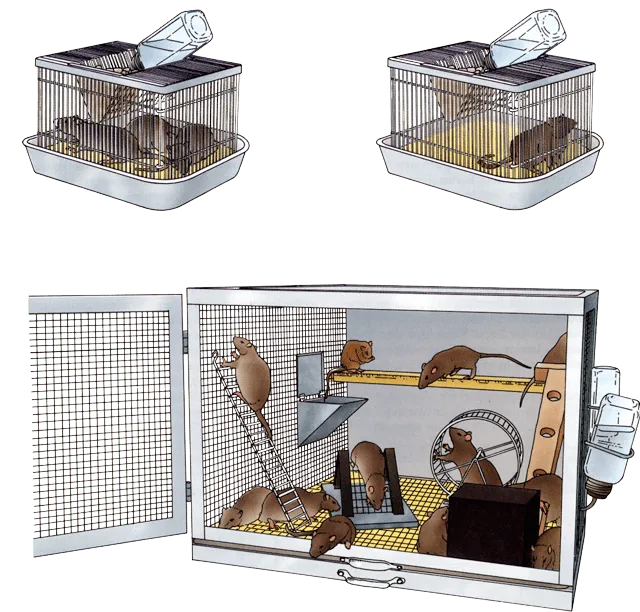
ADHD and Environmental Enrichment
Animal research suggests that Environmental Enrichment and enhanced Multisensory Stimulation can impact core symptoms of ADHD.
Utsunomiya R, Mikami K, Doi T, Choudhury ME, Jogamoto T, Tokunaga N, Ishii E, Eguchi M, Yano H, Tanaka J. Rearing in an Enriched Environment Ameliorates the ADHD-like Behaviors of Lister Hooded Rats While Suppressing Neuronal Activities in the Medial Prefrontal Cortex. Cells. 2022 Nov 17;11(22):3649. doi: 10.3390/cells11223649. PMID: 36429076; PMCID: PMC9688563.
Coopersmith R, Weihmuller FB, Kirstein CL, Marshall JF, Leon M. Extracellular dopamine increases in the neonatal olfactory bulb during odor preference training. Brain Res. 1991 Nov 8;564(1):149-53. doi: 10.1016/0006-8993(91)91365-8. PMID: 1777817.
Corredor K, Duran JM, Herrera-Isaza L, Forero S, Quintanilla JP, Gomez A, Martínez GS, Cardenas FP. Behavioral effects of environmental enrichment on male and female wistar rats with early life stress experiences. Front Physiol. 2022 Sep 26;13:837661. doi: 10.3389/fphys.2022.837661. PMID: 36225294; PMCID: PMC9548697.
Batistuzzo A, de Almeida GG, Brás TS, Zucato VP, Arnold AJT, Giannocco G, Sato JM, Yamanouchi LM, Dias E, Lorena FB, do Nascimento BPP, Bianco AC, Ribeiro MO. Multisensory Stimulation Improves Cognition and Behavior in Adult Male Rats Born to LT4-treated Thyroidectomized Dams. Endocrinology. 2022 Sep 1;163(9):bqac105. doi: 10.1210/endocr/bqac105. PMID: 35914267; PMCID: PMC9354969.
Groß C, Serrallach BL, Möhler E, Pousson JE, Schneider P, Christiner M, Bernhofs V. Musical Performance in Adolescents with ADHD, ADD and Dyslexia- Behavioral and Neurophysiological Aspects. Brain Sci. 2022 Jan 18;12(2):127. doi: 10.3390/brainsci12020127. PMID: 35203891; PMCID: PMC8870592.
Hobbiesiefken U, Mieske P, Lewejohann L, Diederich K. Evaluation of different types of enrichment - their usage and effect on home cage behavior in female mice. PLoS One. 2021 Dec 23;16(12):e0261876. doi: 10.1371/journal.pone.0261876. PMID: 34941949; PMCID: PMC8699725.
Chan YS, Jang JT, Ho CS. Effects of physical exercise on children with attention deficit hyperactivity disorder. Biomed J. 2022 Apr;45(2):265-270. doi: 10.1016/j.bj.2021.11.011. Epub 2021 Nov 29. PMID: 34856393; PMCID: PMC9250090.
Ball NJ, Mercado E 3rd, Orduña I. Enriched Environments as a Potential Treatment for Developmental Disorders: A Critical Assessment. Front Psychol. 2019 Mar 6;10:466. doi: 10.3389/fpsyg.2019.00466. PMID: 30894830; PMCID: PMC6414413.
Normann MC, McNeal N, Dagner A, Ihm E, Woodbury M, Grippo AJ. The Influence of Environmental Enrichment on Cardiovascular and Behavioral Responses to Social Stress. Psychosom Med. 2018 Apr;80(3):271-277. doi: 10.1097/PSY.0000000000000558. PMID: 29360667; PMCID: PMC8283515.
Human translation
What we have done is to translate animal model protocols into short, fun, hands-on games you can do at home, at school or in your treatment facility.
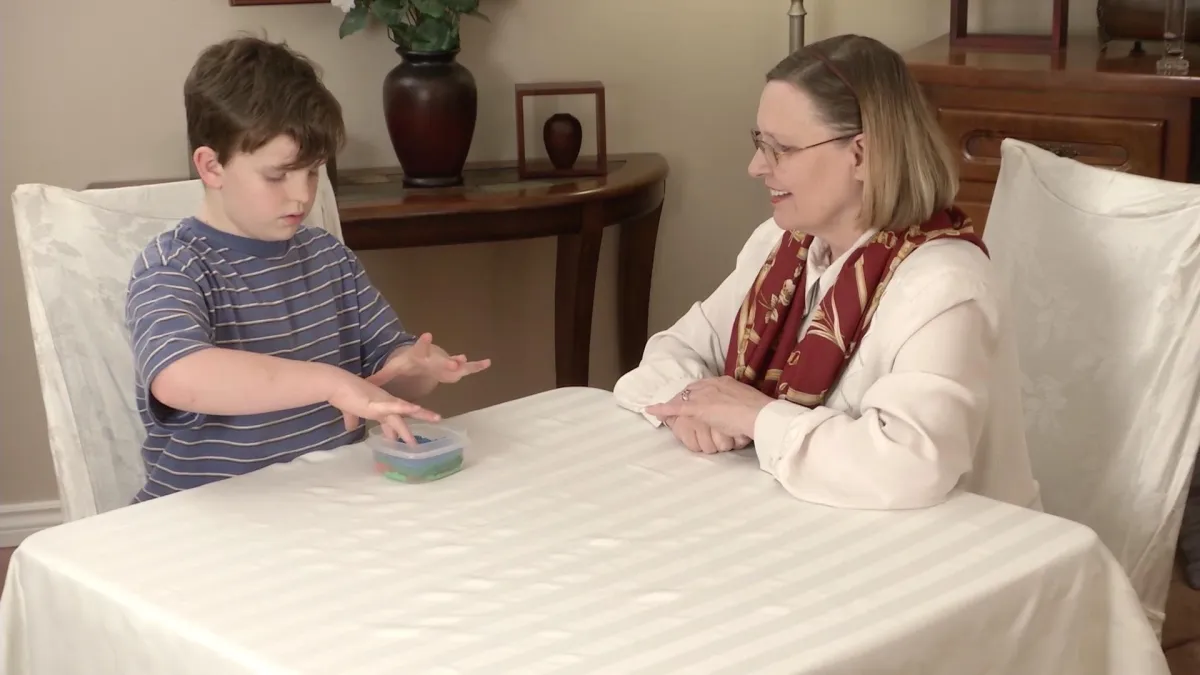
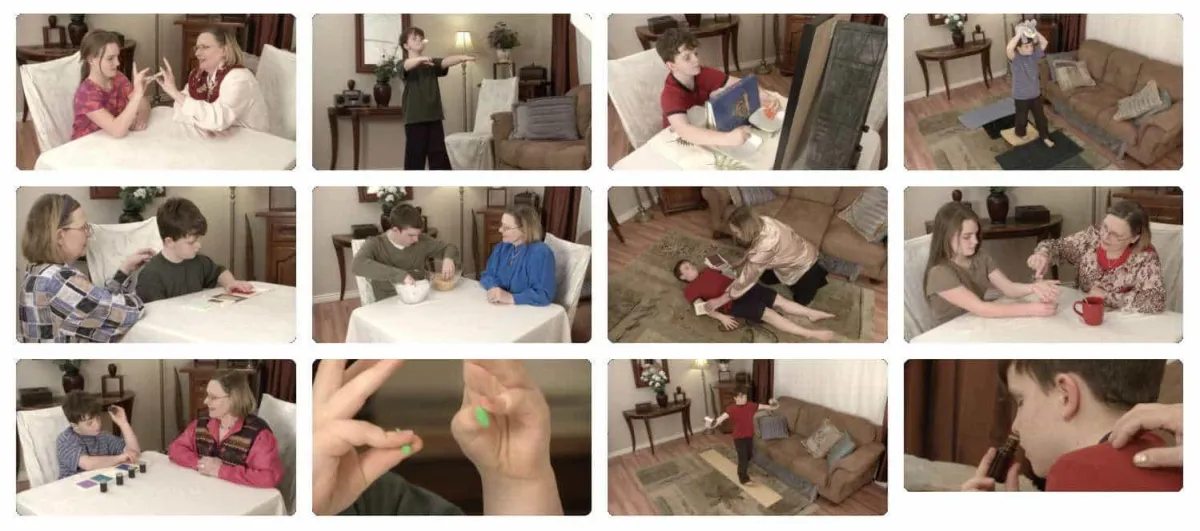
More questions? More examples of games?
Improved Attention
Poor attention span in ADHD results from a combination of:
- neurochemical deficits (dopamine and norepinephrine),
- functional differences (imbalanced DMN and TPN activity), and
- structural challenges (delayed maturation of the prefrontal cortex).
These factors make it difficult to initiate, sustain, and regulate attention, especially for tasks that are repetitive or lack intrinsic interest.
In clinical studies, it has been shown that Sensory Enrichment therapy can improve attention span in 6 months by an average of 10%.
This means that in a year, what used to be a major problem is now a minor problem, or what was a minor problem is now maybe a problem.
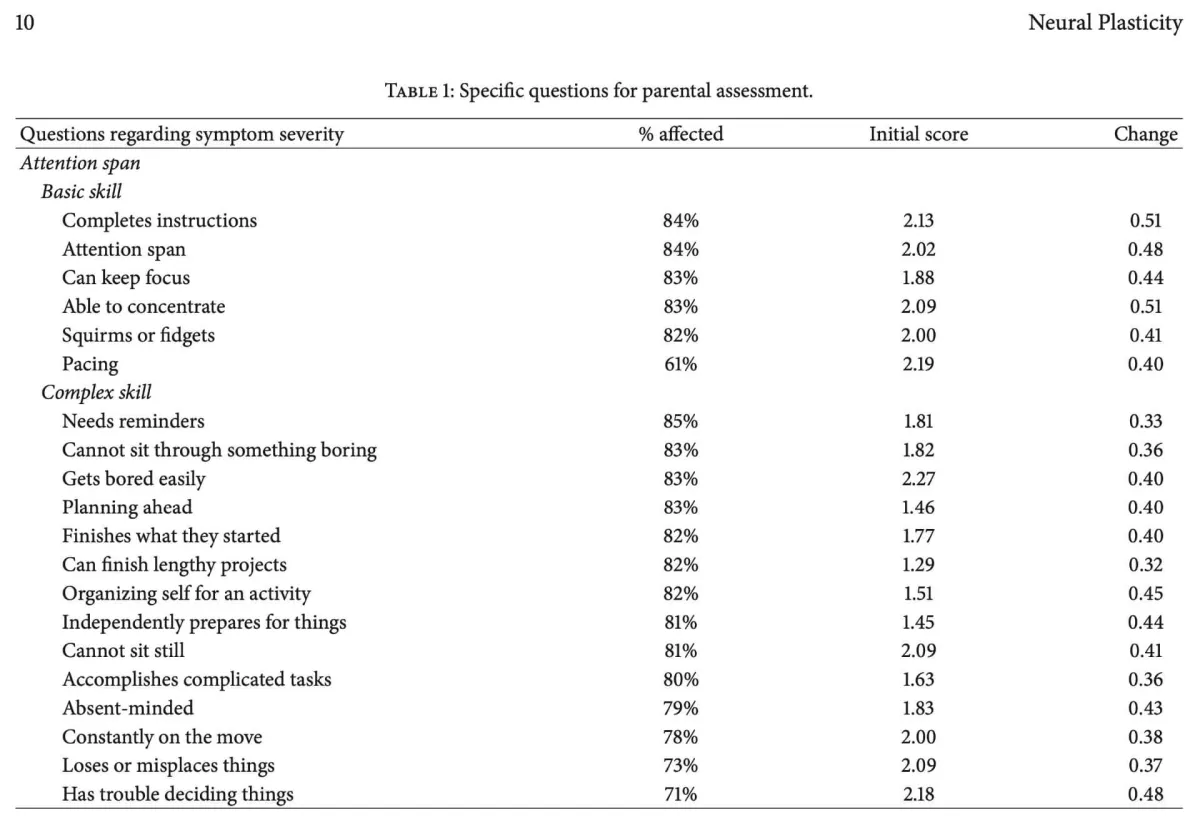
The table above shows the areas tracked by the program and by how much they changed on average over a population of 1,002 children aged 1-18. The scores are change are measured on a scale of 1 to 5.
Enhanced Motor Skills:
Our sensory enrichment activities are designed to improve coordination, balance, and fine motor skills by creating new connections in the brain through novel sensory experiences.
Below are the improvements measured in motor skills in 1,002 children aged 1 to 18, after 6 months of Sensory Enrichment Therapy. The study was published in Neural Plasticity in 2016.
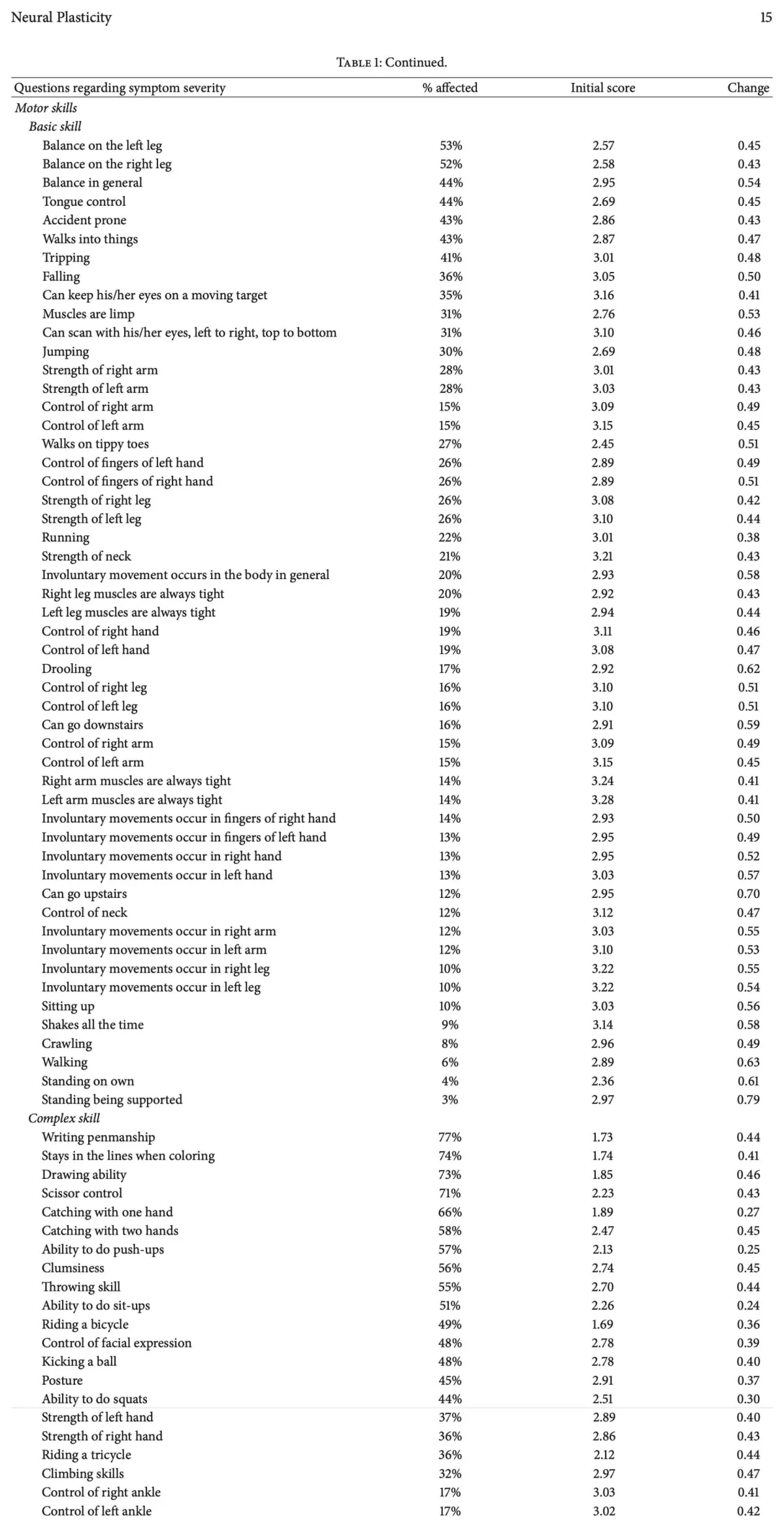
Better Sleep Patterns
Sleep disturbances are common in individuals with AS. Our program includes sensory activities that help regulate the brain’s sleep-wake cycle, promoting better sleep quality and duration.
Below are the improvements measured in sleep patterns in 1,002 children aged 1 to 18, after 6 months of Sensory Enrichment Therapy. The study was published in Neural Plasticity in 2016.

Reduced Anxiety and Behavioral Challenges
Individuals with Angelman Syndrome may experience heightened anxiety and behavioral issues. Sensory Enrichment Therapy helps calm the brain by regulating sensory input, leading to a more balanced emotional state and a reduction in challenging behaviors.
Below are the improvements measured in anxiety and behavior in 1,002 children aged 1 to 18, after 6 months of Sensory Enrichment Therapy. The study was published in Neural Plasticity in 2016.
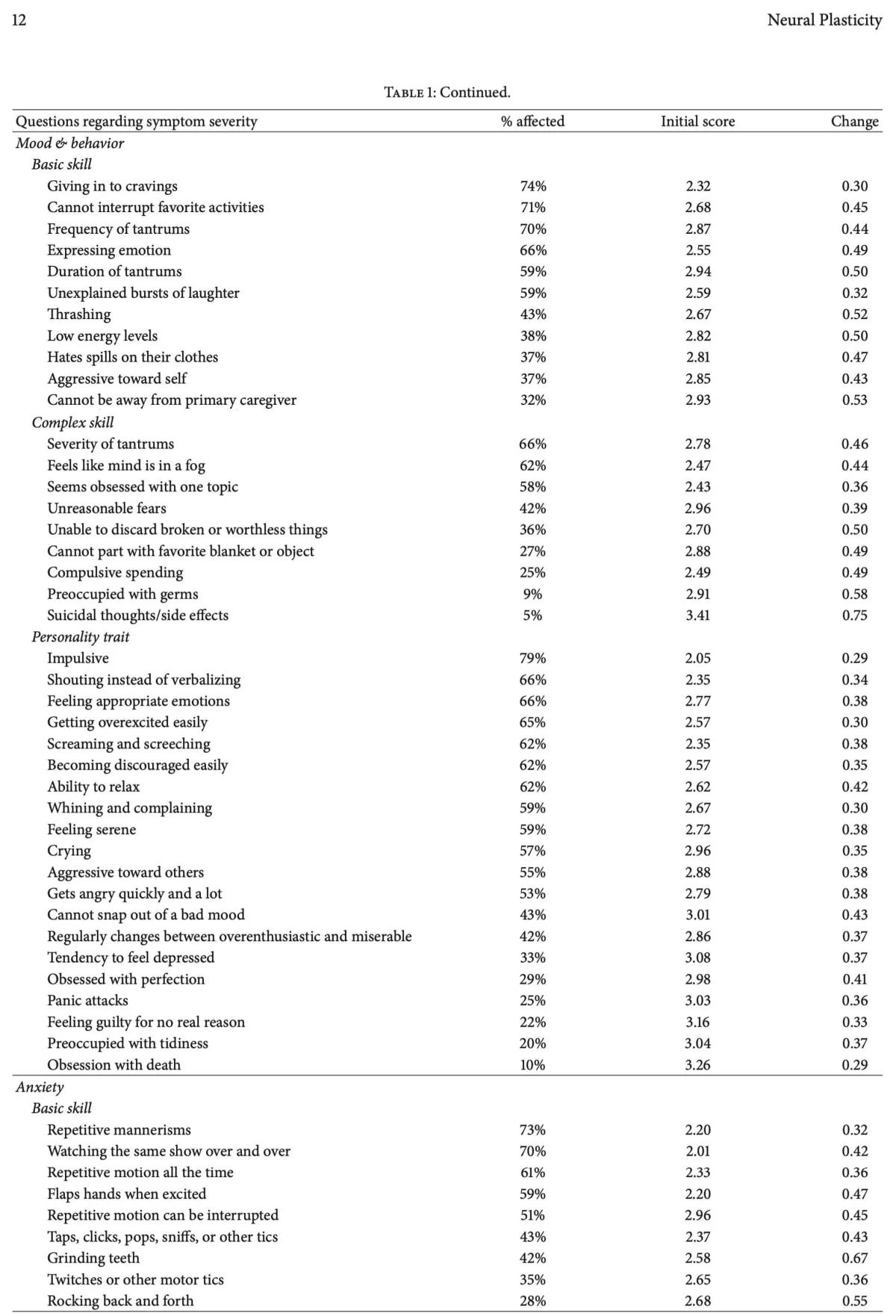
Ready to Get Started?
Why not schedule a Free Consultation?
What if there was a way to support your child’s brain and finally help them with all of that…
…with a full money-back guarantee!
3,000+
Join 3,000+ other families who have also followed Mendability's Sensory Enrichment Therapy!
“This is really working! My toddler has started using functional language!
His cognition has improved, his motor skills are getting way better, he is finally starting to climb and point and wave and able to copy signs. He has been blossoming intensely, really catching up at a faster rate. Now we have SO much hope!”
– Melissa M. (New Zealand)
parent of a 3-year-old boy
“I think that [my son] is responding great to the therapy! He definitely seems to be following instructions better across the board and is just a little more aware of the world around him.
We have also seen some improvements in speech, pronunciation, eating, handwriting and overall function.”
– Sara J. (California)
parent of a 4-year-old boy
“I went to the library where we spent about 2 hours, and both of the girls were happily reading while staying in their seats. In our prior visits, the oldest one just roamed and ran around the library while I chased her. This time, I was pleasantly surprised by how long my oldest daughter (4) sat and stayed focus on reading. This has never happened before!”
– Mary M. (Texas)
parent of a 4-year-old-girl

The top 5 areas where parents report the most improvements in the first few weeks are Sleep, Eating, Social Skills, Attention and Sensory Processing
Tailored enrichment therapy is designed to boost brain plasticity in targeted brain functions
• Emotion (motivation to engage with other people),
• Self-awareness (where do I fit in space and this social world?),
• Fine motor (can I control my voice box, lips, breathing, etc.?),
• Auditory processing (can I hear myself speak?),
• Memory and learning (vocabulary, sentence structure),
• Mental image (can I picture what I want to say in my mind?), etc.
As these tools improve in the brain, the bottlenecks that slowed down natural speech development should fade away.
2011 - 2026 © Mendability - All Rights Reserved
